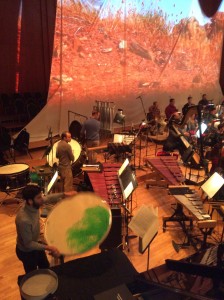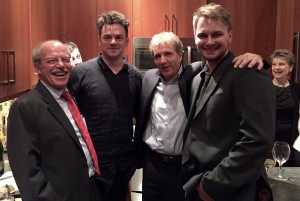Pre-concert interview from December 5, 2015 featuring Nico Muhly & Josh Higgason with Glenn Prestwich, representing the Sounds of Science Commissioning Club (SOSCC)
SOSCC: Nico, in the program notes for Control, you describe it as “five episodes describing elements of Utah’s natural environment and how people interact with it.” In a minute, I’ll ask you about each movement, but first can you give us the big picture, and how the composition came to be?
Nico: The Utah Symphony gave me a “dream commission:” write a piece about Utah and join us for our tour of five national parks in Utah. I said, “Sign me up”; I learned that Utah has incredibly diverse landscapes, like twenty different universes of visualization. Also, Control was written to give Maestro Thierry Fischer a lot of latitude and flexibility for interpretation, for play in the musical space, for balance, to highlight the talents of his newly acquired musicians’ talents, and to foster interfamilial interactions among instrumental siblings. In this way, he creates moments of chamber music within a symphonic landscape.
SOSCC: You told me earlier about the importance of the “back of the orchestra” as agents of change. What did you mean and how can we look and listen for this?
Nico: In general my music, like geology, is layered and contrasting, e.g., fast vs. slow, like water moving over rocks formerly shaped by moving water. In a musical sense, the brass and percussion create strong vertical chordal columns, contrasting with the fluid horizontal movement of the woodwinds and strings. It’s like plate tectonics occurring under bumblebees.
SOSCC. Another bit of science, and a question: it turns out that calcite or limestone, is the glue that cements sand, silt, and mud to make rocks under pressure. What is the musical glue that holds this work together?
Nico: It has a lot to do with repetition, like water following a course and carving a new course for itself. Repetition and also interruption; the process turns 180 degrees when something awful happens. The orchestra sort of forces a static thing into a new, pressurized situation.
SOSCC: So, that’s interesting. For me – a scientist who loves music – I understand the landscapes of Southern Utah in terms of four main forces: geology, meteorology, chemistry, and biology. Uplift and erosion shape the land, and chemistry and biology create its color and texture. From your point of view as a composer, how can science and music inform each other?
Nico: Hearing you describe this, it’s very similar to how I describe music; we are using the same words. I really like these textures, these vertical moments of simultaneous information and horizontal moments providing directional flow. This is how the land works, and one of the advantages that we have tonight is the video instillation that makes visual many of these moments. Like in the fifth movement, we have rivers in St. George choked with red dirt.
Josh: Yes, there was a moment with a rainstorm during the film, with the color of river dark red and surreal and you can see and here the color and texture together.
Nico: And musically you can be very mathematical about how things relate with little patterns that flow. Then, when the river turns red in sort of a Ten Commandments moment, then you want big drums and the tympani.
SOSCC: Josh, can you tell us the importance of video in the live experience of a world premiere such as that we’ll experience tonight. How does it differ from films for the silver screen? Can you describe to us how you and Nico co-developed the overall performance art piece?
Josh: Video and music synergize each other in a live performance, which is completely unlike writing for a movie screen. This is not a film that commands your attention. Often it is intended to push your attention back into the orchestra, and have your attention move around to all the exciting things happening. Here, Nico wanted many fewer cuts, and longer pans to focus the audience’s attention to bows and the horns and all the hitting and moving on stage. This creates the maximum tension and enhances the musical experience, by for example big and slow vs. intimate and fast.
SOSCC: Josh, How did you choose the unusual sail-like fabric for the projection surface?
Josh: We’ve been trained to lean back and watch a big rectangular screen or big boxes, as passive observers. These swags or mountains of cloth asks the audience to lean forward, become actively involved with the action on stage both as listeners and observers. Your energy helps the performers stay fully engaged. The live music and video together provide an unparalleled total experience with action, tension, and drama that is unavailable in a recording.
SOSCC: Nico, now tell us a little about each of the movements and what the audience should listen for. The first movement (Landforms), like geology, is layered. This makes scientific sense to me also: The geologic movement is very slow, but sped up becomes a fluid process. We see a hoodoo or ridgeline or layers of rocks as static and fixed, yet this is the result of many years of processing frozen in time. It seems that music can accomplish a sort of time-lapse effect superimposing the static grandeur with rapid movement. Can you describe how or where we can listen for these effects in Landforms, particularly in terms of the contrast of the grandeur of complex low brass chords with insects and bird movements in the upper voices, solo oboe, and the compelling and urgent trio of pitched percussion.
Nico: As I said before, there are repeated cycles of chords. The goal is a large stack of vertical objects, like a hoodoo is a big vertical pile, a Looney-Tunes massive thing. The idea is you create that with a million moving parts, turning around each other, really an illusion of solidity. The tension is between things that are moving very very fast and things that don’t move at all. The percussion trio is riverish, but more about rocks than water. For me, that is marimba, xylophone, and vibraphone playing with very dry sticks. Timbre can suggest certain structures.
SOSCC: In the second movement (Mountain), I think of the Wasatch, big and majestic, but you’ve chosen a softer, warmer vision. First, can you explain the use of ricochet on the strings – how does the ricochet connect with mountain?
Nico: The strings are very still; however, the last player in each section, like the 17th first violin, have pop-out solo roles, by dropping their bows onto the strings to create an effect of insect-like buzzing like cicadas or crickets. Usually, the mountains are skied on, but what about in the summer?
Josh: Yes, we shot these at Park City in the summer. Fields, sculpted slopes, and shot ends on a snow-maker that is a strange surprise and unexpected weird landscape feature.
SOSCC: In the third movement (Beehive), the arrival of pioneers leads effectively to a “change of control”. This happens in all scientific disciplines. We control conditions in an experiment, but we cannot control fundamental processes or outcomes. Can you tell us about the musical gestures that convey this dichotomy of control in your piece?
Nico: I’m interested in the history of Utah, which is so tied up with industriousness and making an inhospitable climate more hospitable. Man has manipulated the land and used it to advantage and make it bountiful, like the collective grain storage and early settlers working together. More recently, Utah became a tech hub – the first telegram, the first fiber optic hub. The land is something with which one dances. Technology was a driver of western expansion. This is a sort of scherzo movement, lots of activity and fun, but it ends in a terrifying way, with a feeling that we have lost control. Indeed, Control captures the basic tension of man vs. landscape; we can shift and alter the landscape in the short term, but ultimately nature regains control.
SOSCC: Nico, tell us about the juxtaposition of vertical and horizontal forms in the 4th movement (Petroglyph & Tobacco), from the simultaneous chordal information for the petroglyph cliffs contrasted with the flow of the trombone line. I found this fascinating and very moving.
Nico: What I did, I wrote this gigantic vertical thing with everyone playing large chords at the same time (the cliff faces), and under the trombone spells out a Ute tune song, which was not passed down culturally but used in interacting with settlers when begging for tobacco. That conflict of thinking something is old, is mirrored by the pre-Columbian petroglyphs juxtaposed with the more recent graffiti of people in the 1920s carving in the rocks. People are more horizontal and more baffling, and this generates different complex lines over the verticals. I’ve modified the tune, throwing it off kilter by adding or skipping beats. Landscapes have broken rules too, thanks to both external forces of man as well as of nature. Yes, humans leave their impact on environment, but the environment leaves its impact on humans.
SOSCC: In the last movement (Red Dirt) the red dirt is also chemically meaningful. The red particles are in suspensions (muddy rivers) or bind to surfaces and fabrics. But to me, red dirt is a sign of being alive – our blood contains an iron-containing protein (hemoglobin) and binds oxygen. Oxygen is why the rocks are red, and oxygen is the key to our life – our blood protein hemoglobin has an iron atom that binds oxygen and makes it red. Oxygen gives us life and ultimately rusts us out. Tell us more about your reaction to red dirt. Finally, in Red Dirt, you employ the géophone, a favorite instrument of Maestro Fischer. Tell us about the importance of this instrument to you and to the piece.
Nico: Complicated prompt but I’m going to do it! I’m from Vermont and I have seen pictures of red, but seeing it in real life is absolutely shocking. It’s not a Yankee red, like a grey or slate. This is bright emergency red, vivid, like blood. I took a hike in St. George, and cleaned up and after driving to Salt Lake, flying to London, taking a getting to my friends apartment, and preparing to shower when a huge cloud of red dust just exploded all over his entryway. It’s not forgettable. Red dust is metaphorically and literally the lifeblood of Utah. Humans think they take control by leaving their mark, carving names into rock as in the fourth movement, but then red dirt symbolizes the persistence of environment on people. It gets everywhere, like glitter – anyplace you take it, you can’t get rid of it; it persists and becomes part of the new place.
Look down to the front left in orchestra to see the géophone, which is a frame drum filled with pellets (green in the photo below) symbolizing earth. The géophone was also used by French composer Olivier Messaien in From Canyon to the Stars, which was also about Utah’s red rock country. It was about stylizing the sounds of the earth and making them beautiful. This instrument is a particular favorite of Thierry Fischer, thus providing another critical connection for the source of inspiration.
L to R: Glenn Prestwich, Nico Muhly, Thierry Fischer, and Josh Higgason (and interim CEO Pat Richards in background)


